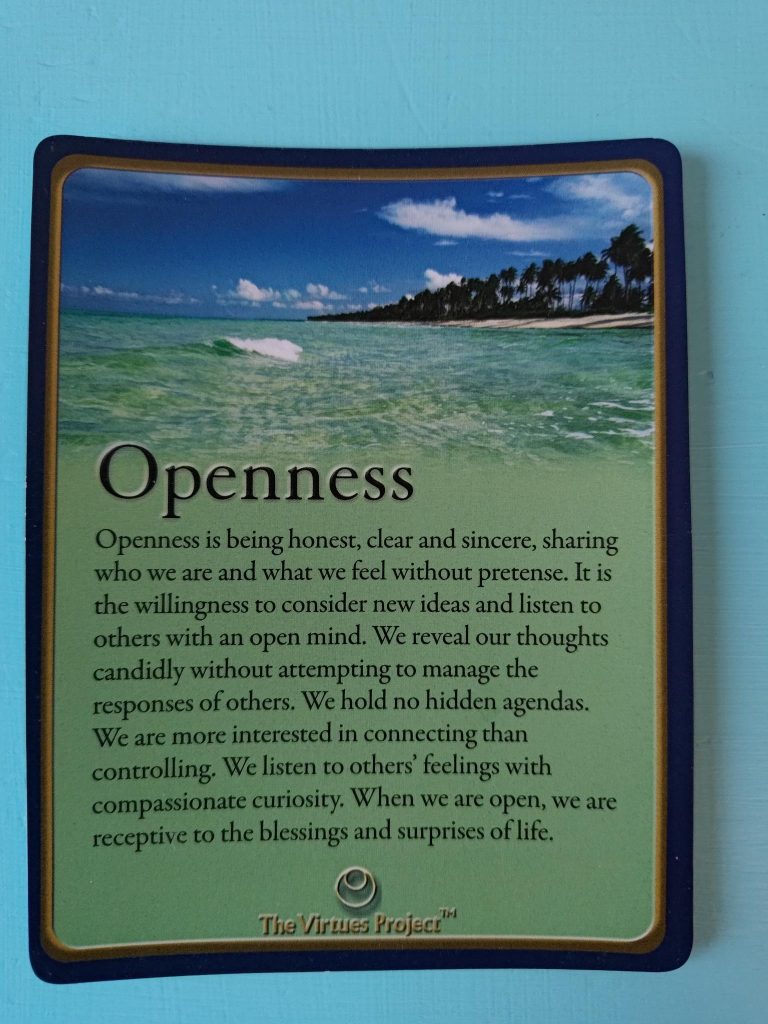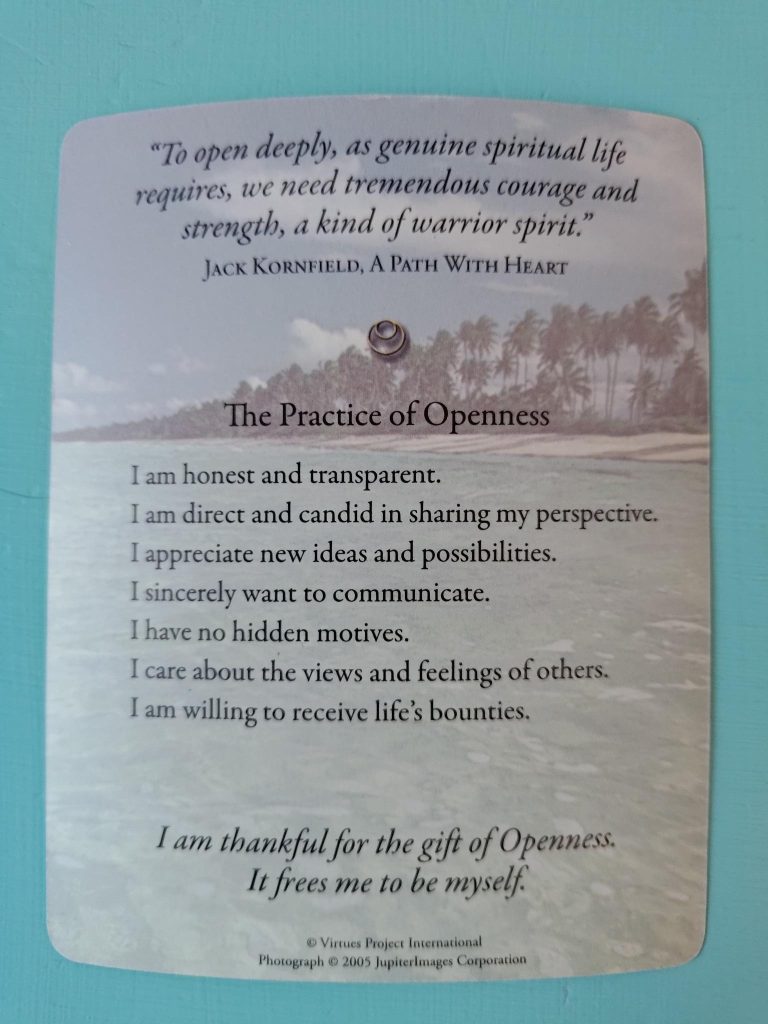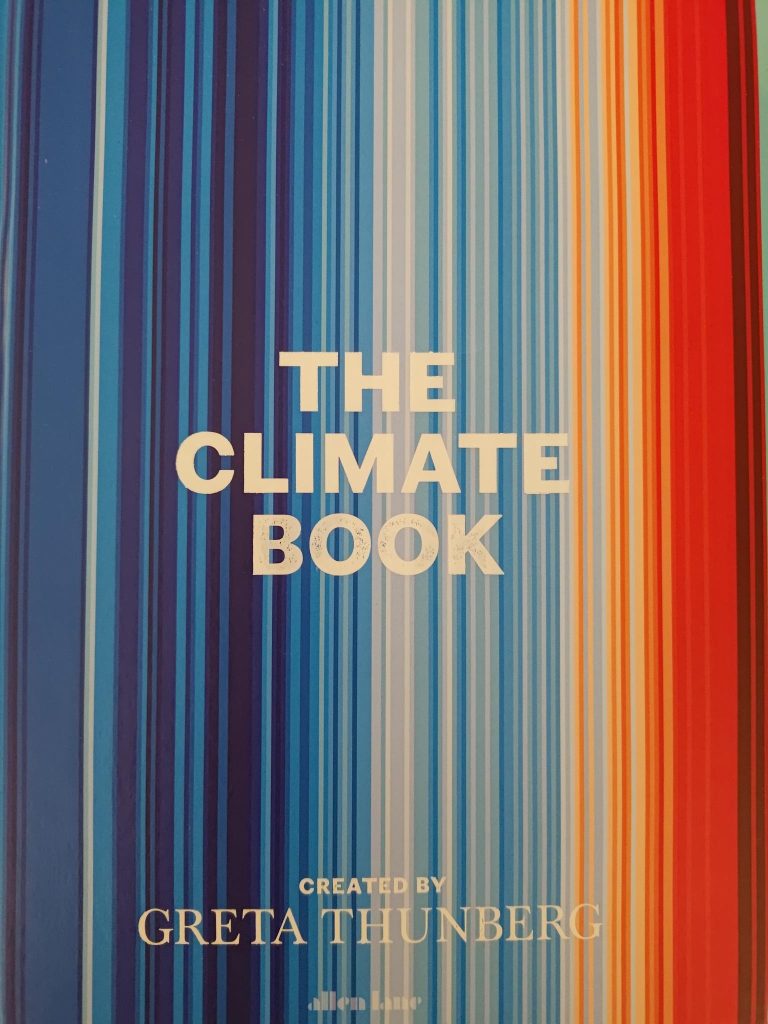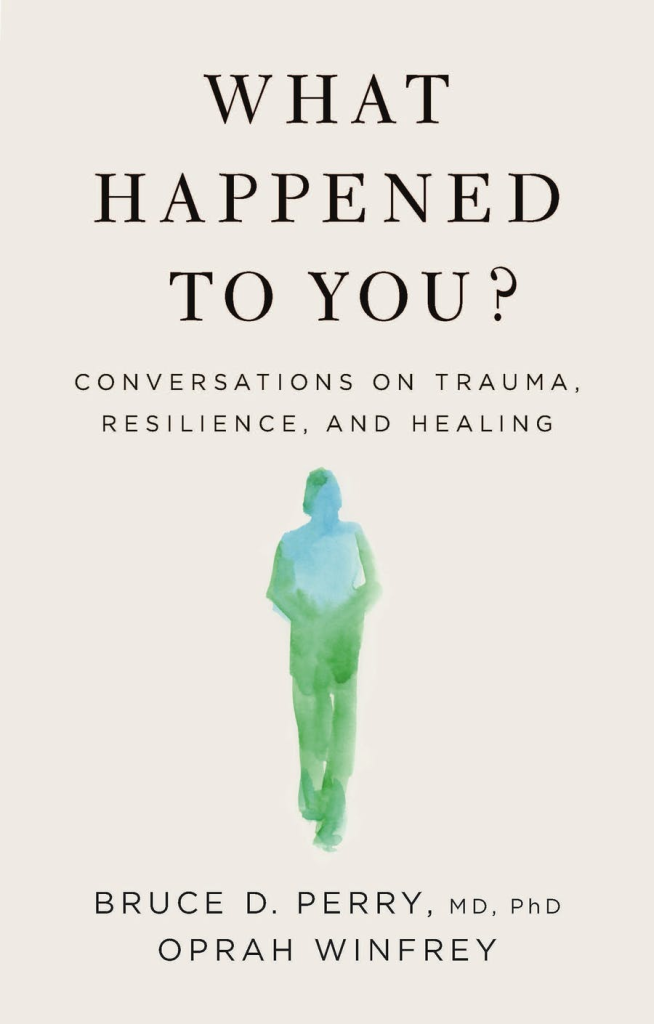This book is written as a conversation between the two authors, Bruce D. Perry and Oprah Winfrey. The subtitle is: “Conversations on Trauma, Resilience and Healing”. This book was published by Flatiron Books, New York, in 2021.
I would like to recommend this book to anyone who works with or has children. It may also give you insights into yourself. I found the presentation of the material easy to understand. The use of examples from the authors’ work, as well as explanations of the science behind the working of the brain, made it easier for me to relate to the material being discussed. I ended up reflecting on a lot of the material, perhaps almost too much, but there were several times while reading the book that I felt that I had really learned something new which I wished I had known a long time ago.
Dr. Bruce D. Perry is a clinician and researcher in neuroscience and psychiatry. He has worked primarily with traumatized children. His role in the book is to explain what is happening in the brain both when a child experiences trauma or neglect and how what happens in the brain affects a person’s experiences later in life.
Opray Winfrey is primarily known as a talk show host with her own show from 1986 to 2011. Growing up in rural Mississippi she experienced much trauma in her childhood and brings personal experience to the book. She has also interviewed many people who have experienced trauma and encourages the reader to understand what has happened to these people that make them the way they became as adults.
These two authors use personal experience and explain the science of what happens in the brain when a person, especially a young child, undergoes a traumatic experience, whether it is short-lived or goes over years. When things go wrong for someone, they are both concerned with what happened to this person in the past, whether it was a week ago, or several decades ago. Using examples and stories of people, the book both tries to explain what happens in the brain, but also what can be done later to heal the person and help them learn a better way of living.
The book is divided into an introduction and ten chapters and I would like to give a very brief summary of what I found most important in each chapter. I recommend this book to everyone, as it will give you a new perspective on the people you either work with or live with and give you, hopefully, an aha experience about yourself and why you are like you are.
Introduction
Our brains are very adaptable and are changing all of the time. “Understanding how the brain reacts to stress or early trauma helps clarify how what has happened to us in the past shapes who we are, how we behave and why we do the things we do.” (Page 9) We must also remember that good experiences also shape the brain.
Using the phrase, “What happened to you?” puts the emphasis on how experiences, both good and bad have shaped us. It made me think of personal things, for example, how my sister and I had very different early years, and how my two children also had very different early years, in spite of growing up in the same family.
Chapter 1 Making Sense of the World
When a baby is born, it begins trying to make sense of their surroundings. “The developing infant acts and feels, and these actions and feelings help organize how they will think.” (Page 19). The child’s individual history influences the way the brain develops with the result that every individual is unique. Everyone sees and understands the world in a unique way.
Through examples and diagrams of the brain, Dr. Perry explains how these unique experiences influence the way the brain develops. “Moment by moment in early life, our developing brain sorts and stores our personal experiences, making our personal codebook that helps us interpret the world. Each of us creates a unique worldview shaped by our life’s experiences.” (Page 21)
The brain grows very rapidly in the first few years of life and the child’s early experiences have a very large impact on the infant and later the child. A worldview is already being formed from day one, whether the child has responsible and good caregivers, or is abused or neglected.
Chapter 2 Seeking Balance
“Rhythm is essential to a healthy body and a healthy mind.” (Page 31) Something rhythmic will help us calm down, whether it is walking, swimming, knitting or dancing. Rhythm is regulating and regulation is about being in balance with ourselves and our world. “When we get out of balance, we become dysregulated and feel discomfort or distress. When we get back into balance, we feel better.” (Page 32)
Babies need to learn self-regulation from the caregivers around them, but much can go wrong if they do not have good caregivers. Babies that grow up in a nurturing, supportive and caring environment are being regulated when the caregiver responds to a cry of distress. “A consistent, nurturing caregiver builds an internal view that people are safe, predictable and caring.” (Page 34) But not all babies are lucky in the caregivers in their lives. The opposite is also discussed in this chapter.
Chapter 3 How We Were Loved
“Belonging and being loved are core to the human experience.” (Page 48) Social interactions are an integral part of being human and it is our earliest relationships that set the pattern for the rest of our lives. “To the newborn, love is action; it is the attentive, responsive, nurturing care that adults provide.” (Page 48) The actions that a baby experiences sets the way the brain develops and the child’s worldview is formed.
Chapter 4 The Spectrum of Trauma
Instead of asking someone or yourself, “What’s wrong with you?”, we need to ask the question “What happened to you?” What we experienced as a child, whether good or bad, influences how we live our lives as adults. This chapter is designed to help you recognize if you have experienced any trauma in your early years. According to Dr. Perry, almost 50 percent of children in the United States have had at least one significant traumatic experience. (Page 62)
This chapter includes a discussion of what the word, “trauma”, means and how it is used. An example is given to show how the same event will be experienced quite differently depending on how the person is involved in the event.
The specific effects of a traumatic event on a person’s health is influence by a variety of factors including genetic vulnerability, the age of the person at which the trauma event happened and any history of previous trauma. Having healthy relationships will also influence positively the effect of a traumatic event. Trauma plays a major role in many mental health disorders, but not all.
Chapter 5 Connecting the Dots
“We absorb things from previous generations and pass them on to the next generation.” (Page 78) This can include a fear of something, for example, dogs. This chapter discusses how fear can be transmitted between generations, “What happened to us?” We inherit more than genes from our parents.
For an individual to make intentional change, he/she must identify what has happened either at the individual level or at the cultural level. Values and beliefs are learned and absorbed from the adults around us and then taught to the next generation. “If we want to enrich the transmission of humane, compassionate values, beliefs and practices, and minimize the transmission of hateful, destructive beliefs, we need to be very mindful of what we’re exposing our children to.” (Page 82)
“Developmental adversity increases the risk for all kinds of health problems, including heart disease, asthma, gastrointestinal problems, and autoimmune disease.” (Page 86) Treating physical health problems has to take into consideration experienced trauma. “Many trauma-related health problems are dismissed, missed, and misunderstood.” (Page 87)
Chapter 6 From Coping to Healing
“Neglect and trauma can co-occur but they cause very different biological experiences and can have very different effects on the brain and the developing child.” (Page 100) There is still a lot to learn about how the brain develops, but research is being done.
It can be that one important area of development, for example, emotional development, is relatively ignored or understimulated. “The key to having many healthy relationships in your life is having only a few safe, stable and nurturing relationships in your first year.” (Page 104) This builds the foundation that allows the child to continue to grow healthy relational connections. Parents have to be fully engaged and present with their children. It matters who is raising a child in its first years.
Dissociation is a coping mechanism that occurs when an individual feels that a threatening situation is inescapable. The child retreats into an inner world and avoids conflict. “People-pleasing is a classic coping mechanism that is part of the compliant behaviors seen with dissociation.” (Page 113)
You can’t get rid of the past, but therapy is about building new associations, making new, healthier default pathways, building a better alternative. (Page 117) But building new alternatives takes repetition and time.
Chapter 7 Post-Traumatic Wisdom
“We are always changing. We change from all of our experiences, good and bad. This is because our brain is changeable – malleable. It’s always changing.” (Page 120) It is impossible to go back to the way things were before a trauma. “Adversity impacts the developing child.” (Page 121) This chapter includes a discussion of what has been learned about how the brain changes when exposed to stress. The experiences a child has had during its first year will influence how it can react to stress situations later in life, even the learning situation of a classroom at school.
“Healthy development involves a series of challenges and exposure to new things. And failure is an important part of the process.” (Page 124) But the challenges have to be reasonable for the child’s, or adult’s, level of development. You can’t learn to write paragraphs until you have learned to write words. “A child in an environment where they feel loved and safe will choose to leave their comfort zone.” (Page 124) Safety and stability are the keys for healthy growth.
Using several examples of how communities offer healing, it becomes clear that a child needs more than one stable adult in their life to be able to experience healthy development.
Chapter 8 Our Brains, Our Biases, Our Systems
“Your past is not an excuse. But it is an explanation” (Page 137) of how we have become the person we are. Healing begins when we can look at the past and work towards a better future. There are still very few professionals and organizations that understand how much trauma people have experienced.
“The complexities of trauma impact all of our systems, from maternal-child health to child welfare to education, law enforcement, mental health and more.” (Page 138) The old ways of doing things take a long time to change, even when it has been acknowledged that they weren’t really working. The term “trauma-informed care” is a term that is used regularly in this chapter to indicate that health care and education need to be more aware of how trauma has affected so many people. The term can be used differently depending on which system you are in, and treatments that are offered can vary widely. The study of trauma is a very young science.
Marginalization, being excluded, minimized or shamed, is also a trauma that dehumanizes many people. Marginalization can occur because of race, gender or sexual orientation. A child with traumatic experiences will often have difficulty learning, often overreacting to the feedback and criticisms that come in an ordinary classroom. (Page 140) This leads to behavioral problems that are often misunderstood. Many children may be diagnosed with ADHD because of their response to stress, but it is really a coping technique that the child has developed based on previous experiences.
“When schools do learn about the effects of trauma and make some simple changes in how they evaluate, support and teach, they see dramatic improvements in academic achievement and decreases in challenging and disruptive behaviors.” (Page 145)
“One of the most important aspects of healing is recognizing that it can involve multiple therapeutic techniques and approaches.” (Page 147) This chapter goes on to explain some of these techniques and how they help. Not everyone can afford or have access to professional help, but having access to several caring people gives better outcomes after trauma. These caring people can be family or community groups.
Chapter 9 Relational Hunger in the Modern World
“We live in environments where we see fewer people, and even when we do see people and engage in conversation, we’re not really listening to each other or being fully present. And this disconnection is making us more vulnerable.” (Page 164) “Our ability as a people to tolerate stressors is diminishing because our connectedness is diminishing… Many people are overly reactive to relatively minor challenges.” (Page 164) It is normal that people miscommunicate but then they repair things This builds resilience. If you walk away, everybody loses. “We all need to get better at listening, regulating, reflecting. This requires the capacity to forgive, to be patient.” (Page 164)
Our modern life gives fewer opportunities to relate to others. We live in smaller family units, or alone. Spending time in front of a screen also reduces the time spent communicating with other people. People have become more self-absorbed, more anxious and more depressed. “I believe we don’t have enough quiet conversational moments listening to a friend with no other distractions.” (Page 170)
Chapter 10 What We Need Now
This last chapter in the book brings an optimistic note to the end of a long conversation between the two authors. Understanding what has happened to people, and knowing the source of a problem, gives a better understanding of how to fix the problem. In addition, a teacher or parent needs to be aware of when a child is in a teachable moment and is able to understand what is being said. These moments may be very short.
“It is never too late. Healing is possible. The key is knowing where to start the process. And matching the developmental needs of the person.” (Page 182)
“When you’ve lived through adversity, you can come to a point in your life where you can look back, reflect, learn and grow from the experience. Adversity, challenges, disappointment, loss, trauma – all can contribute to the capacity to be broadly empathic, to become wise.” (Page 184)
I have given a few excerpts direct from the book with the intention of encouraging you to read the book for yourself. Some of the stories in the book are very disturbing and perhaps you will need to put it aside or hop over parts of it. But the authors are optimistic that healing is possible for those who have had traumatic experiences.




